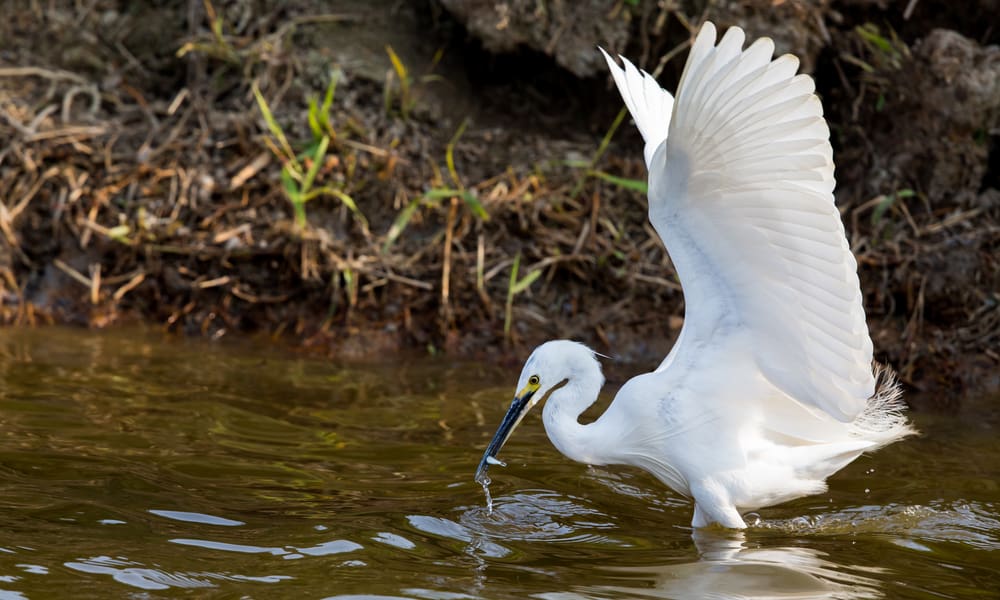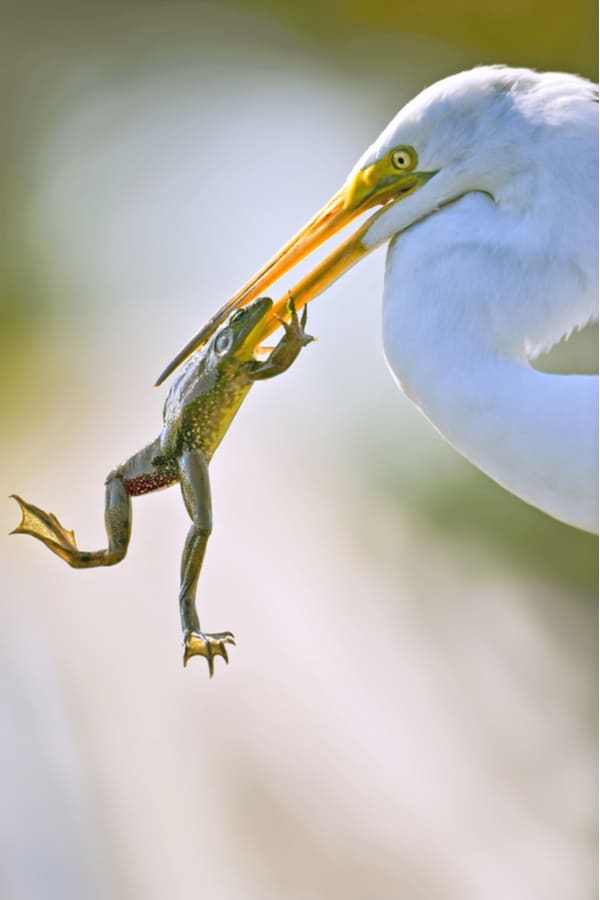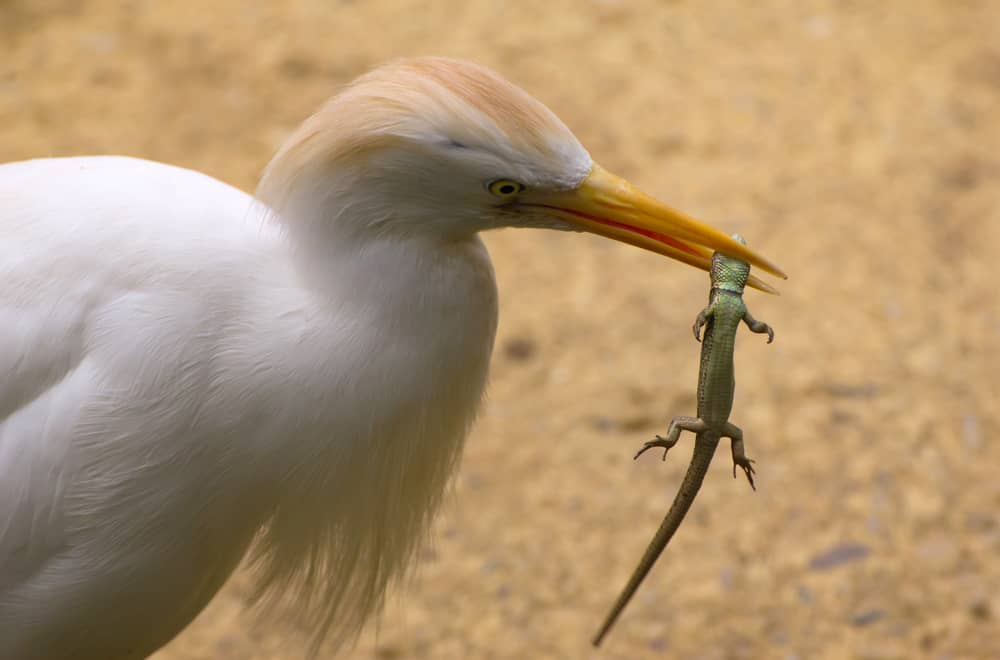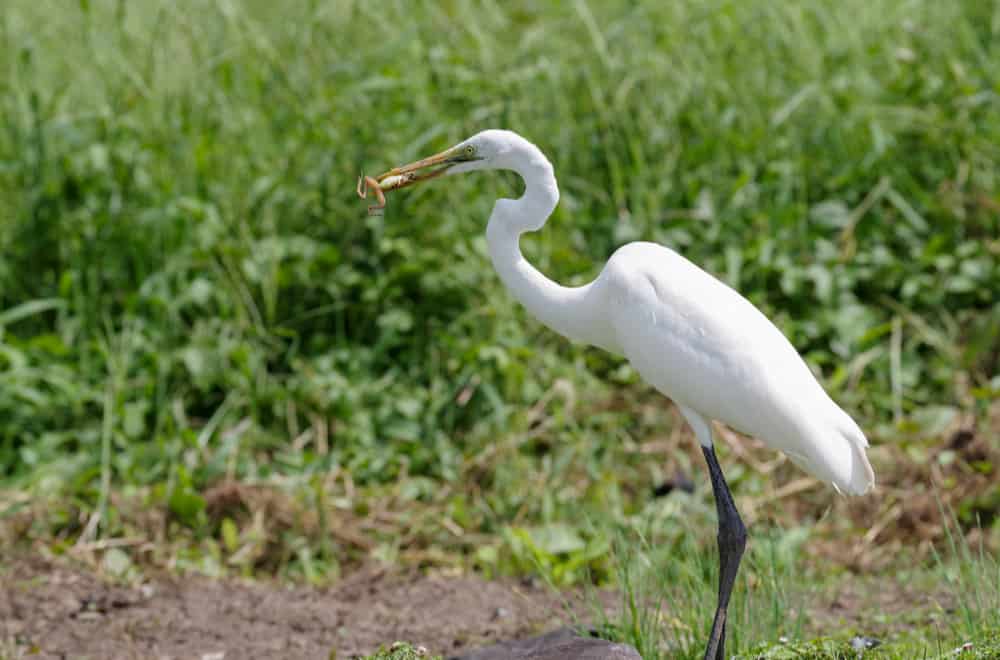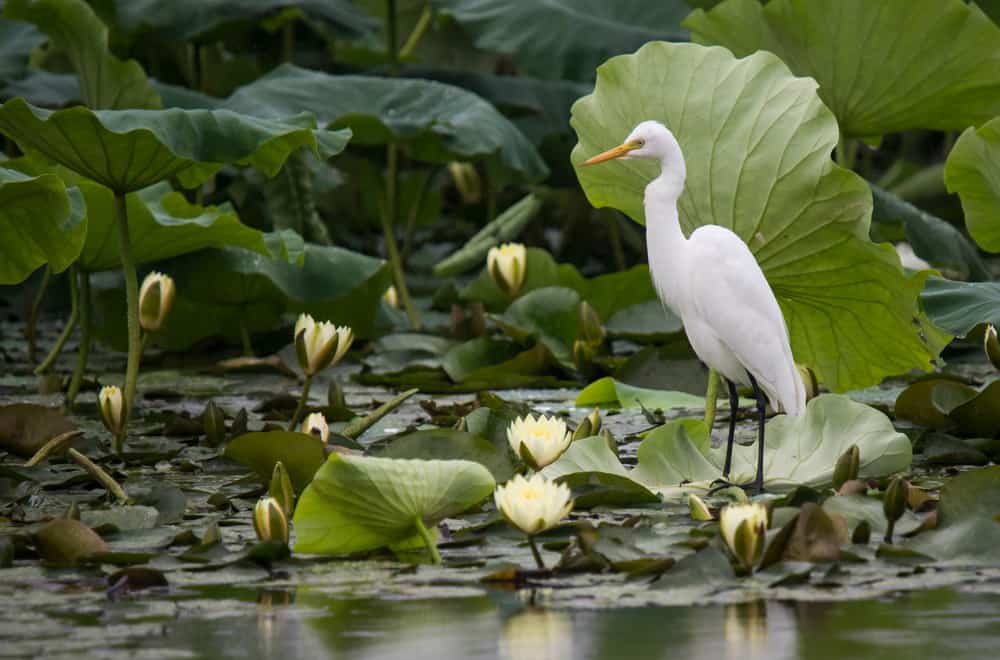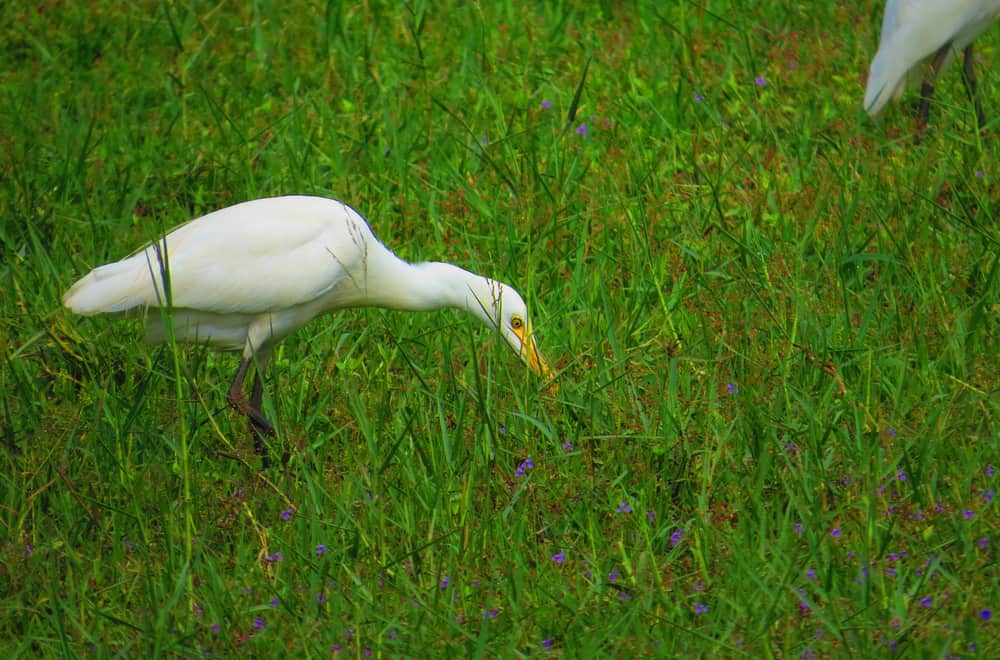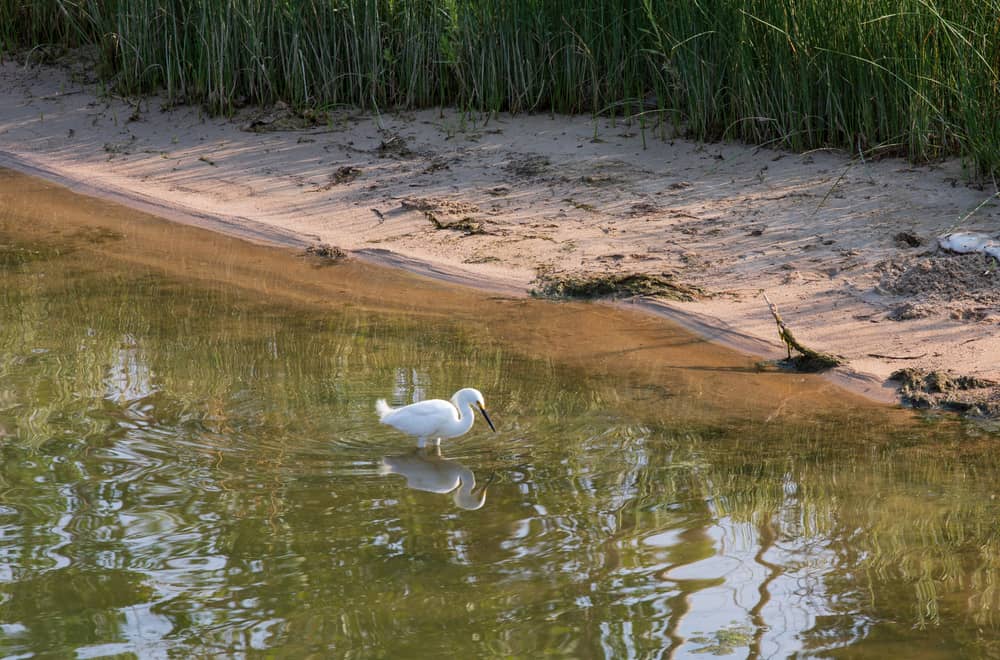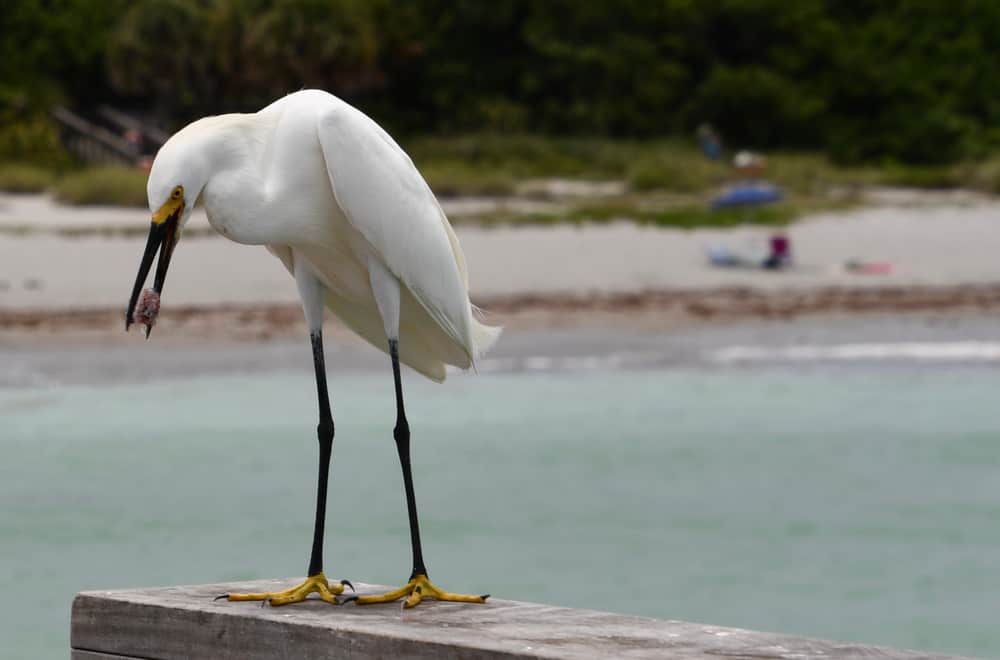Are you wondering what egrets eat to survive? And, what does a baby egret eat? And, if or not they eat grass?
Well, if all these questions are troubling your head, you’re at the right place! In this post, you’ll find all the information regarding egrets and their eating behavior. Further, we’ll also discuss the four most common egret species and their appearances.
Though egrets look fairy-like white and elegant, they actually predate on smaller organisms to survive. In fact, these stunning long-legged creatures belonging to the family Ardeidae are carnivorous. Let’s dive deep and find out what type of living beings do egrets prey on!
What Does Egret Eat?
So, what do egrets like to eat? In this section, let’s dissect egrets’ day-to-day diet, shall we?
1. Fish
Fish is the diet staple of egrets. They love eating fish and enjoy almost any type of fish they can capture.
Egrets spend most of their day roaming around shallow water sources. Their long slender legs and lengthy flexible necks make it easier for them to search for their food on shallow waters.
Thanks to egrets’ incredible eyesight and sharp bills, they can easily catch fish and other aquatic animals such as crustaceans.
2. Amphibians
Not only fish, amphibians such as frogs, salamanders, toads, and tadpoles, also make a major portion of egrets’ diet. Such amphibians are also great sources of proteins to these carnivorous birds.
As egrets, these amphibians also live around shallow water sources, thus making them perfect foods for egrets.
3. Reptiles
It is given that these egrets attack and swallow reptiles crawling around shallow water regions. But, they also catch inland reptiles such as lizards while flying. Egrets have great eyesight and are able to spot reptiles even when they are flying at fast speeds.
Egrets can even spot, catch, and kill snakes. We all know how fast a snake can crawl. But egrets use their big wings to distract it, bite them with their pointed bills unless the snake dies, and swallow them whole.
4. Insects
Egrets, especially cattle egrets, also do enjoy preying on large insects. If your home lies in its habitat, you might have encountered them multiple times on your lawn. They’re lurking in and looking for insects such as grasshoppers, crickets, and flies.
Cattle egrets swallow insects that are distracted and displaced from their hiding places when livestock moves around a pasture.
5. Small birds and animals
It might be hard for you to believe, but these innocent-looking white birds are also known to kill and eat small birds and animals. If they’re very hungry, they even fight big birds to survive. Else, they choose a smart decision only to attack small chicks and birds that are easier to catch and kill.
Likewise, these birds also feed on small animals such as rabbits, squirrels, and other rodents such as mice and rats. In fact, these birds try to eat almost any bird and animal they’re confident of beating. They will prey on any living creature that is smaller in size than they themselves are.
What Do Baby Egrets Eat?
Egrets lay around 2-5 eggs at once. Baby egrets, called chicks, get a lot of support from their parents during the initial month or two. In the first few days, the parents feed the chicks by regurgitating food back to them.
As the chick grows, the parents feed them with small chunks of meat and fish. It takes around a month for a baby egret to fully fledge. However, the parents will support the chicks until they are capable of searching for food and hunting on their own.
How Do Egrets Look?
Now that we’ve discussed what egrets feed on to survive, let’s discuss how these birds look before moving on to discuss more of their feeding habits.
There are around 11 species of egrets identified to date. However, below we mention four popular egret species; cattle egret, snowy egret, reddish egret, and great egret.
Cattle Egret
As the name suggests, these egrets roam around grazing cattle. They are small herons and are often called with common names such as cow egrets, cow cranes, cowbirds, rhinoceros egrets, or elephant egrets.
Rather than feeding on bugs from livestock’s bodies, they catch bugs that are displaced from their hiding places when cattle move around the pasture while grazing.
Snowy Egret
Snowy egrets have black legs and brilliant yellow feet and are prevalently found in the swamps and marshland of Lemoyne.
Their feet have a greenish-yellow hue for the rest of the year, while the color becomes bright orangish-yellow during the breeding seasons. Adult snowy egrets develop wispy feathers on their back, head, and neck during breeding seasons.
Reddish Egret
Reddish egrets are medium-sized and are grayish to pinkish in color. Adults morphs have greyish shaggy heads and necks. These egrets enjoy shallow water and are found exclusively around the coasts.
On the other hand, white morphs reddish egret have a white body and dark grey long legs.
Great Egret
As the name suggests, this egret species are relatively larger. They have a long S-shaped neck with a pointed dagger-like bill.
Like snowy egrets, these egrets also develop large plumes on their back during the breeding season. These large feather-like plumes, which they utilize as props during courtship displays, are called aigrettes.
What Should You Feed Egrets In Captivity?
Egrets are often fed with a variety of their favorites in captivity. However, their two most common meal must be rodents and fish, as these are easy and harmless to catch.
Though egrets prefer a fresh kill for their meal, they can also be taught to eat pre-killed meat. So, if the situation demands, they can also be fed lean carrion meat in captivity.
Egrets Feeding Habit
Egrets are opportunistic feeders, meaning they will grab and eat any possible food they encounter. So, there might be days when they’ll eat plenty of times per day while feeding only once or twice some other days.
However, for a baby egret to survive, they must be fed at least four times a day. But adult egrets are known to survive with only one big and nutritious meal per day.
When it comes to hunting strategy, egrets wait for their prey to come in near vicinity to them. They kill them with a quick thrust of their bill and swallow the prey whole.
Egret Habitat And Distribution
Though a few egret species were extensively hunted down in the earlier century for their plumes, causing their species to decline, thanks to the conservation, egrets are one of the birds that have undergone a successful and rapid wide-range expansion.
Great egrets are found worldwide in tropical and temperate regions. These are partially migratory birds and migrate from the northern hemisphere to the south to escape the cold winters.
Egrets are today found across Africa, Europe, Central America, North America, South America, Asia, Australia, as well as the surrounding islands.
As the majority of egrets survive off of aquatic animals, many egret species are found living around shallow water bodies, like ponds, lakes, wetlands, or streams. Likewise, they also roam around agricultural lands, including dry farms.
Do Egrets Eat Bread?
If a bird or an animal relies on a carnivorous diet, it means that their diet constitutes a high amount of protein. Bread, on the other hand, is rich in carbohydrates.
Most humans love bread; egrets might eat it too if fed every once in a while. However, making bread a part of egrets’ regular diet is not a good idea.
Bread doesn’t provide these birds with enough nutrition, and the birds might end up suffering from malnutrition if forcefully fed a bread-rich diet every day. Also, stale loaves of bread are often moldy, which might cause lung diseases, even to egrets.
Do Egrets Eat Grass?
No, egrets don’t eat grass. In fact, they don’t even feed on bird seeds, fruits, and vegetables. Egrets neither have teeth set, nor a digestive system evolved to chew and digest plant materials.
Why Do Egrets Stand On One Foot?
You might have noticed egrets standing on one leg, posing as if they’re ready to perform a quick and smooth ballerina turn. The most probable reason why many birds, including egrets, stand on one leg is to minimize the heat loss from their legs.
As opposed to their body, egrets have naked legs without any feathers. So, standing on one leg is believed to reduce the amount of heat loss from their unfeathered legs.
Summary
As egrets were extensively hunted during the 19th and 20th centuries for their plumage, they are considered endangered birds. Thus, they are under legal protection, and rightfully so. These stunning birds should be protected at all costs.
One of the best ways of doing so is by providing them with enough food to eat. So, if you ever encounter an injured or famine egret looking for food, or if a few are in captivity nearby, you know all of the foods that egrets like to feed on, don’t you?
